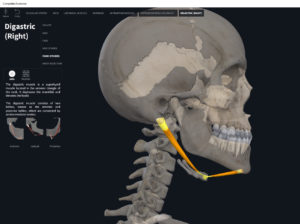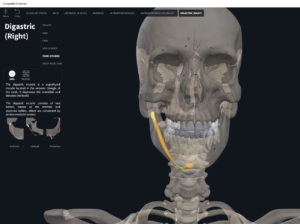Anatomy & Physiology: Muscles—Digastric.
Structure.
- Origin: Anterior belly: digatric fossa on deep surface of symphysis menti. Posterior belly: mastoid process of temporal bone.
- Insertion: hyoid bone via intermediate tendon.
Function.
- Concentric action: depress, retract mandible; flexes head/neck; head extension.
- Reverse mover action: elevate hyoid.
- Eccentric action: controls/restrains/slows elevation and protraction of mandible; extension of head/neck; flexion of head; depression of hyoid.
- Isometric action: stabilization of hyoid.
- Innervation: trigeminal nerve V, facial nerve VII.
- Arterial supply: occipital, posterior auricular, and facial arteries.
Clinical Significance.
More.
- https://www.anatomynext.com/content/digastric
- https://www.youtube.com/watch?v=CxqCWyindCI
- https://www.youtube.com/watch?v=Md9b1YyUPew
References
Biel, A. (2015). Trail guide to the body: A hands-on guide to locating muscles, bones and more.
Cedars-Sinai. (2018). Vertebrae of the spine. Retrieved from https://www.cedars-sinai.org/health-library/diseases-and-conditions/v/vertebrae-of-the-spine.html
Clark, M., Lucett, S., Sutton, B. G., & National Academy of Sports Medicine. (2014). NASM essentials of corrective exercise training. Burlington, MA: Jones & Bartlett Learning.
Jenkins, G., & Tortora, G. J. (2012). Anatomy and Physiology: From Science to Life, 3rd Edition International Stu. John Wiley & Sons.
Muscolino, J. E. (2017). The muscular system manual: The skeletal muscles of the human body.



